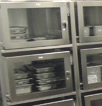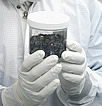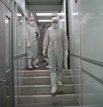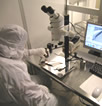 |
|
Cataloged wafer fragments are put in storage until requested by scientists worldwide |
|
Where do you think you would find the world’s most valuable collection? Most people might guess the Tower of London, the Louvre, the Smithsonian, or some other renowned location. But you can make an awfully good argument for the Astromaterials Curation Labs at Johnson Space Center (JSC) in Houston, Texas. That is where NASA keeps the Genesis solar wind samples, the Stardust comet and interstellar dust particles, the Apollo moon rocks, meteorites recovered from Antarctica, and cosmic dust harvested from the stratosphere—the most scientifically diverse accumulation of extraterrestrial material anywhere on this planet.
Each of the five collections has its own dedicated suite of super-clean laboratories, and the Genesis laboratory consists of the two cleanest rooms that NASA operates at any facility. Their heavily filtered air is certified to contain less than 10 particles measuring half a micron or larger per cubic foot. That’s 1000 times cleaner than the typical hospital operating room.
This meticulous level of cleanliness may be surprising given that the vast majority of the Genesis samples are still dirty from the return capsule’s crash landing in the Utah desert. But Genesis curator Judy Allton explains that the facilities were constructed not only to preserve and process the samples after they were brought to Earth, but also as a place to clean and assemble the science canister before it was launched into space. That’s when the curation team helped engineers from NASA’s Jet Propulsion Laboratory (JPL) to employ the extraordinary measures required to keep Earthly particles away from the materials that were to capture atoms from the solar wind. “The JPL engineers had never done this before,” Allton said. “It was a big culture shock to them to be totally encased in these clothes (an extreme kind of cleanroom suit), and to not touch any of their fasteners with the gloved hands, to use tweezers to install all of the screws and washers. But they responded magnificently.”
| |
 |
| |
Recovered fragments from the Genesis landing site |
Because the impact of the landing smashed many of the science canister’s sample-containing wafers to bits, the curation team—charged with preserving, cataloging, and distributing the samples to investigating scientists—has more than 10,000 pieces to manage instead of the anticipated few hundred. And the team takes great care to prevent any further contamination problems.
 |
|
Members of the Genesis Curation team �suit up� to enter the cleanroom |
|
Before entering the Genesis cleanroom, you must empty your pockets, remove all cosmetics and jewelry, don shoe covers, a hair net, and gloves, and attest that you are a freshly showered non-smoker. You are now ready to enter the gowning room, where you will put on a full-coverage cleanroom suit (known as a “bunny suit”) along with knee-high boots, a surgical facemask, a hood, and a second pair of gloves. According to Allton, the people working in the lab even control their movements in ways designed to keep the air from getting turbulent and stirring up whatever dust particles manage to sneak through all the safeguards.
First, do no harm
While waiting for the spacecraft to return from its four-year journey, the curation team worked closely with Genesis scientists and engineers on preparations to keep the precious cargo of solar atoms intact and isolated from the identical atoms found everywhere on Earth. Rather than allow the return capsule to drop all the way to the Utah desert floor by parachute, plans called for a helicopter to retrieve it in mid-air and gently lower it to a cradle just outside the door of the building in which a specially built temporary cleanroom awaited its arrival. There, the team would prepare it for transport to its ultra-clean permanent home in Houston. Failure of the parachute’s triggering mechanism spoiled those plans, but the team was ready.
“We were prepared, if something should go wrong, to pick up the pieces,” Allton said. “We had little collection kits and buckets and 6000 pre-numbered bags we had stashed out there for Plan B, as it were. We were focused on the end goal, and that was to get the samples into a clean environment as soon as possible.”
“As we were wheeling it (the crushed science canister) in,” she continued, “I have to admit it looked pretty sad. And I remembered when we closed it up here (at JSC, before launch), it was so beautiful. We had a lot invested in this jewel.”
Jack Warren, who is known among JSC curation staff for having opened the first box of Apollo moon rocks, was on the team that took part in recovering the science canister. “We brought it in there, we photographed the living daylights out of it, and then we started thinking about what’s the best way to go after the samples,” he said “We were there for four weeks, picking all that stuff out.”
Why didn’t the recovery team clean the samples before shipping them to the cleanrooms at JSC? Because no cleaning process would be safe for all the samples. The wrong method could contaminate some of the samples, wash away the solar wind atoms, or otherwise interfere with the various investigation procedures that may be brought to bear. So the guiding principle for the Genesis team was the same as for doctors: first, do no harm. Cleaning decisions for each piece are left to the scientists who will investigate that piece, and the samples not yet needed for investigation are kept as they were when they were recovered in Utah.
Sorting it out
Once the sample fragments were safely at JSC, Allton said, “we got them under dry nitrogen, mostly to keep the humidity down, because humidity will encourage chemical reactions between the collectors and any of the contaminants that are on them.”
The next priority was to distribute samples to Genesis scientists who would develop customized cleaning strategies and begin analysis of the solar wind particles. Then, in spring, 2008, the team began a dedicated effort to catalog the larger pieces.
The cataloging process consists of taking a sample out of the container that carried it from Utah, photographing it, identifying it by the composition of the collector material and the array it was part of in the science canister, entering the information into a database, and sealing the sample into a new container. Measuring the thickness of the piece is a key part of the identification process because, fortunately, each array had been given a unique thickness just in case similar-looking collection wafers were broken or dislodged during flight. “Had they not done that,” Allton said, “we would not be able to tell them apart.” Cataloged pieces are listed on the curation web site.
| |
 |
| |
On-going analysis and cataloging at JSC Curation facility |
As of September, 2008, about 400 samples have been lent to science teams around the world who seek to uncover the secrets of the solar wind. When a request for a sample is approved, the curation team checks the database to see whether something matching the request has already been logged. If not, they search through the containers from Utah. If needed in order to locate a sample that meets an investigator’s requirements, a member of the curation team will screen a number of candidate pieces with one of the lab’s two microscopes to map the positions of contaminating particles, and/or examine it with an instrument called an “elipsometer” to determine the thickness of the thin organic film that coats many of the pieces.
On request from the principal investigator in a given science team, the curators will clean a sample with ultrapure water energized by megasonic waves (ultrasonic waves at a frequency of one million cycles per second) to dislodge and wash away debris, or with ozone under ultraviolet light to break down the film.
In addition to the samples, the curation team stores and manages some 1800 non-flight reference pieces, duplicates of the collectors that flew aboard the Genesis spacecraft. Most are blank “before” pieces that enable scientists to compare the “after” pieces that were exposed to the solar wind. Some contain atoms that were artificially embedded to simulate the solar wind samples. Science teams use these reference pieces to test their instruments and rehearse the procedures they plan to use on the actual samples.
While the bulk of the samples are kept at JSC, some of the Genesis, Stardust, and Apollo samples are secured at a backup site in New Mexico. “You don’t want all your eggs in one basket,” Allton said.
Can do
Asked to compare the experiences of opening the first box of Apollo lunar samples and helping to salvage the Genesis samples, Warren replied, “I had more fun in Genesis, because opening the first (lunar) rock box was routine. We had practiced it, practiced it, practiced it, and nothing happened. But Genesis crashed. We had to get our act in gear and take care of this problem.
“Back during the lunar days,” he recalled, “since we were trying to beat the Russians, we were working more or less continuous 7/12s (7 days a week, 12 hours a day). And it was exciting because we were doing something that never had been done before. What I liked about Genesis and Stardust was it got back to the same kind of teamwork and camaraderie and can-do attitude.
“We retrieved a minimum of 85% of everything that was sent up as collector material,” Warren said. “You’ve got to make the best out of what happened and try to get the most data that you can, and that’s what we did. And I’m proud of it.”
~~~ |
